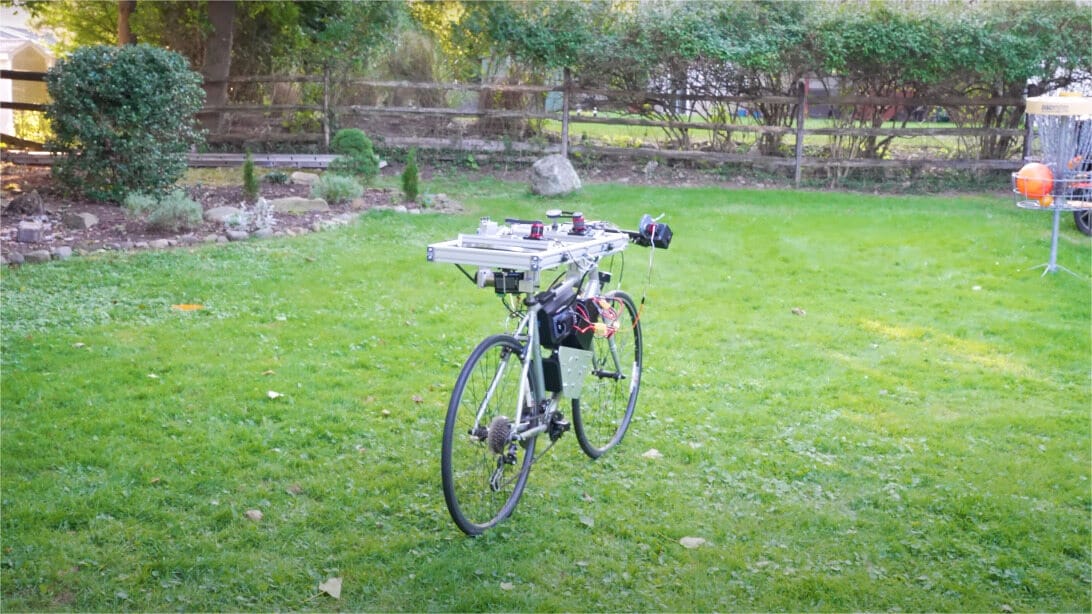Think of a bicycle that can stand up by itself – like those self-balancing robots you might have seen, but bigger. A team of engineers recently built exactly that, hoping to make cycling safer for everyone.
“If I told you there are tens of millions of bike-related injuries every year,” the team explains in their documentation, highlighting why they took on this challenge.
The bicycle works like a high-tech spinning top. It uses two heavy spinning weights (called gyroscopes) that work like invisible hands, pushing the bike back up when it starts to tip over. The first version used 7-pound weights spinning at 4,000 RPM, while the final version used weights three times heavier spinning at 6,000 RPM.
The team hit several bumps along the way. Their first attempt used 7-pound weights, but these weren’t strong enough. They had to switch to weights three times heavier to get enough force to keep the bike upright.
The biggest breakthrough came when they found a special sensor from a company called Wit Motion. Think of this sensor as the bicycle’s inner ear, helping it know which way is up, even when everything’s shaking. “We couldn’t believe that the sensor was able to completely filter out the vibration,” the team noted during testing.
When they finally got it working, the bicycle could balance perfectly still and even ride in straight lines. It used a powerful 13-horsepower motor to move around. However, just like learning to ride a bike, turning proved tricky. The bicycle would get confused and fall over when trying to make curves.
While the project shows promise for making bicycles safer in the future, it also reveals how complex seemingly simple actions – like keeping your balance while turning – can be for machines to copy.
Similar Posts
This version maintains the simple language and relatable explanations while sticking strictly to the facts from the source material. All technical specifications and measurements are directly quoted from the original documentation.
Think of a bicycle that can stand up by itself – like those self-balancing robots you might have seen, but bigger. A team of engineers recently built exactly that, hoping to make cycling safer for everyone.
“If I told you there are tens of millions of bike-related injuries every year,” the team explains in their documentation, highlighting why they took on this challenge.
The bicycle works like a high-tech spinning top. It uses two heavy spinning weights (called gyroscopes) that work like invisible hands, pushing the bike back up when it starts to tip over. The first version used 7-pound weights spinning at 4,000 RPM, while the final version used weights three times heavier spinning at 6,000 RPM.
The team hit several bumps along the way. Their first attempt used 7-pound weights, but these weren’t strong enough. They had to switch to weights three times heavier to get enough force to keep the bike upright.
The biggest breakthrough came when they found a special sensor from a company called Wit Motion. Think of this sensor as the bicycle’s inner ear, helping it know which way is up, even when everything’s shaking. “We couldn’t believe that the sensor was able to completely filter out the vibration,” the team noted during testing.
When they finally got it working, the bicycle could balance perfectly still and even ride in straight lines. It used a powerful 13-horsepower motor to move around. However, just like learning to ride a bike, turning proved tricky. The bicycle would get confused and fall over when trying to make curves.
While the project shows promise for making bicycles safer in the future, it also reveals how complex seemingly simple actions – like keeping your balance while turning – can be for machines to copy.
This version maintains the simple language and relatable explanations while sticking strictly to the facts from the source material. All technical specifications and measurements are directly quoted from the original documentation.







